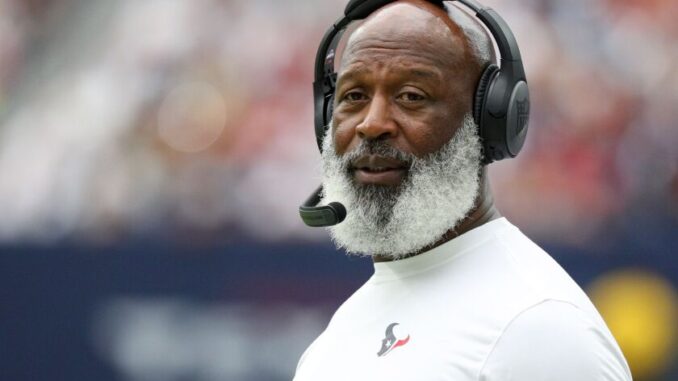Debate Ignites: What Was the Worst Mistake in Chicago Bears History? Firing 10-Win Lovie Smith Tops the List for Many

In a franchise as storied as the Chicago Bears—one that dates back to the very roots of the NFL and boasts a legacy filled with legends like Walter Payton, Mike Ditka, and Dick Butkus—decisions made at the front office level have carried monumental consequences. While the Bears have experienced moments of greatness, they’ve also suffered through decades of missteps, misfires, and mismanagement. But one move stands out above the rest as the worst mistake in franchise history for many fans and analysts alike: firing Lovie Smith after a 10-win season in 2012.
It was a decision that still baffles even the most pragmatic fans over a decade later. Smith, who had served as head coach from 2004 to 2012, was let go despite leading the Bears to a 10-6 record that year. He finished his Chicago tenure with an 81-63 regular season record, including three double-digit win seasons, a Super Bowl appearance in 2006, and a dominant 5-3 record against the Green Bay Packers’ Aaron Rodgers-led squads. So why did the front office pull the trigger?
The answer is part hubris, part shortsightedness, and entirely emblematic of the Bears’ tendency to undervalue stability and overestimate the promise of the unknown.
Then-GM Phil Emery, who had only just arrived in 2012, wanted “his guy” at the helm. He was reportedly frustrated by the lack of playoff appearances in the two seasons prior and sought an offensive-minded coach who could modernize the team. In that search, Emery turned to Canadian Football League veteran and then-Montreal Alouettes coach Marc Trestman—a hire that turned out to be one of the most disastrous in NFL memory.
Trestman’s tenure lasted just two seasons. The Bears went 8-8 in his first year and an abysmal 5-11 in his second. His teams lacked discipline, leadership, and identity. The defense—once the pride of Lovie Smith’s regime—collapsed into one of the league’s worst. Locker room turmoil became the norm, and the franchise quickly found itself rudderless. The front office had gambled everything on change, and it backfired spectacularly.
But it wasn’t just Trestman’s failures that made Lovie’s firing so egregious—it was what Smith represented.
Lovie Smith brought structure, professionalism, and consistent competitiveness to a franchise that often lacked all three. His “Cover 2” defense made the Bears feared once again. Under his watch, stars like Brian Urlacher, Lance Briggs, Charles Tillman, and Devin Hester thrived. His teams played hard, played smart, and never beat themselves. And perhaps most importantly—he understood the gravity of the Bears-Packers rivalry. That alone earned him loyalty from the fanbase.
His firing sent a clear message: Winning isn’t enough unless you win our way. It was a textbook example of an organization overthinking itself out of success.
Critics of Lovie Smith’s tenure point to a lack of playoff consistency—only three trips in nine seasons. They highlight the late-season collapses and conservative offensive philosophy. Those criticisms are fair to a point. But ask any Bears fan today: Would you trade a decade of Lovie’s steady hand for the chaos that followed?
After Smith’s firing, the Bears burned through head coaches like paper. Trestman was followed by John Fox (14-34 in three seasons), Matt Nagy (a promising start that dissolved into dysfunction), and now Matt Eberflus, who enters 2025 under immense pressure to turn things around with rookie quarterback Caleb Williams.
That’s the ripple effect of firing Lovie Smith. The franchise hasn’t recovered its footing. A revolving door of regimes has led to inconsistent roster building, failed quarterback development, and a culture that seems perpetually in flux. Even when Smith had a down year, the Bears were still respectable. Since his firing, respectability has often felt like a pipe dream.
It’s telling that in the decade following his dismissal, Smith remains a benchmark for fans when evaluating coaching candidates. “Is he a Lovie Smith type?” has become a shorthand for discipline, accountability, and defensive toughness—values that used to define Chicago Bears football.
In hindsight, Smith’s last season in Chicago may have been one of his best coaching jobs. The 2012 Bears started 7-1 before a rash of injuries derailed the season. They finished 10-6—an impressive record in most contexts, and typically more than enough to retain a head coach. But not in Chicago, where optics and ego took precedence over results.
To understand the full weight of the mistake, one must also look at what the Bears could have built with just a bit more patience. Jay Cutler was still in his prime. The defense, though aging, had enough pieces to contend. A smarter move would have been to pair Smith with a more innovative offensive coordinator rather than scrapping the foundation entirely. But the Bears chose the sledgehammer instead of the scalpel—and paid dearly.
This isn’t to suggest that Smith was perfect or that firing a coach should never happen. But when a coach delivers consistent winning seasons, understands the city, connects with the locker room, and builds one of the league’s best defenses, pulling the plug becomes less of a strategic move and more of a self-inflicted wound.
Now, in 2025, the Bears are trying to build again—with a generational quarterback talent in Caleb Williams, a promising core on offense, and another defensive-minded head coach in Eberflus. But the ghost of Lovie Smith still lingers. His firing stands not only as a point of regret, but as a lesson: stability and winning should never be taken for granted.
Lovie Smith may not be in Chicago anymore, but his impact endures. And for many Bears fans, the day he was let go remains the moment the franchise veered off course—a mistake that still defines the modern era of Chicago Bears football.



